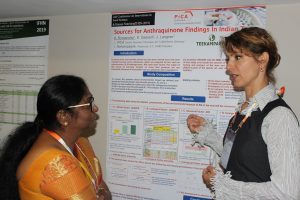The European maximum quantity for the two substances mentioned above is to be reduced to the analytical limit of quantification. This has already happened for etoxazole and will happen very soon for bifenazate. This also means that the two substances may no…
>> Read more
Analysis of benzene in propellant gases
PiCA Prüfinstitut Chemische Analytik GmbH now offers the analysis of benzene CAS 71-43-2 in so-called propellant gases (such as propane, butane, isobutane, etc.) by headspace GC/MS. The determination limit for this highly sensitive analysis is 0.1 mg/kg.
Fast and reliable analysis of ethylene oxide (incl. 2-chloroethanol) in food
Ethylene oxide (EO, Oxiran, CAS Nr.: 75-21-8) has been used in the past for fumigation (an insecticide), especially in the storage and transport of grain, seeds and nuts. It has also been used together with a higher amount of carbon dioxide under…
>> Read more
Important information for our customers – Our laboratory remains open
Due to the COVID-19 pandemic, PiCA Prüfinstitut Chemische Analytik GmbH has taken numerous internal measures to continue processing incoming samples on time and in the usual quality. Should there be any delays in individual cases, you will be informed in good time….
>> Read more
Identification of nicotine sources in indian tea
A. Hofmann, A. Romanotto, K. Speer**, K. Gassert*** **Technische Universität Dresden I Professur für spezielle Lebensmittel-chemie/ Lebensmittelproduktion *** Teekampagne, Potsdam Winner Poster Award RAFA 2019 Investigations of the German Federal Institute for Risk assessment (BfR) in 2009 demonstrated that various plant-based foods…
>> Read more
Target screening of acrylates from UV-curing inks and coatings in food contact material
Ultraviolet (UV) cured coatings show excellent appearance, durability, and little or no volatile organic compound (VOC) emissions, while enabling increased productivity and lower overall costs. An UV-curable coating is one of the best finishing methods in the paper and packaging industries for…
>> Read more
Sample preparation for multi-residue analysis in difficult matrices with an optimized push-through-SPE
Analytical methods have to be fast and easy and to be able to recover a large number of analytes. The analysis of pesticide residues in spices, herbals, tea or hops is considered difficult due to the complexity of the matrix. With the…
>> Read more
Sources of Nicotine in dried mushrooms
A discussion about the source of Nicotine (NIC) in boletus (Boletus edulis) was started in the EU in 2009. No clear conclusion about the nicotine source in wild dried mushrooms was reached [1,2]. In 2010 the specific MRL of 2.3 mg/kg for…
>> Read more
Determination of oxy-PAHs and N-PACs in foodproducts
Polycyclic aromatic hydrocarbons (PAH) are well known contaminants in food. Their mutagenic and carcinogenic effects lead to significant human health risk. [1] However the oxidized form of PAHs (oxy-PAH) and the nitrogen containing polycyclic aromatic compounds (N-PAC) have rarely been researched so…
>> Read more
PiCA at the 2nd IFHN-2019 conference in London
Sources for Nicotine and Anthraquinone in Indian Tea A. Romanotto, A. Hoffmann, PiCA GmbH Berlin, Germany K. Gassert, Teekampagne, Potsdam, Germany K. Speer, Technische Universität, Dresden, Germany Introduction: In recent years, tea (camelia sensis, camelia assamica) has been viewed more and more…
>> Read more

